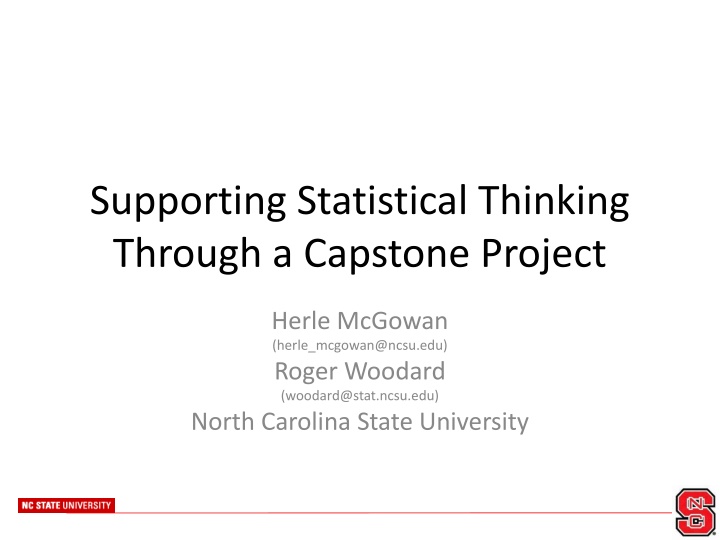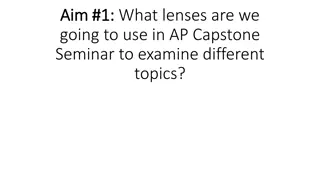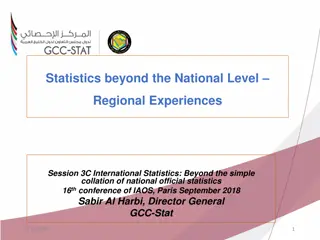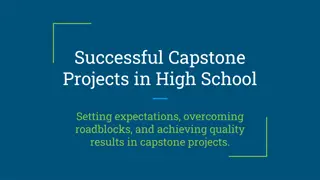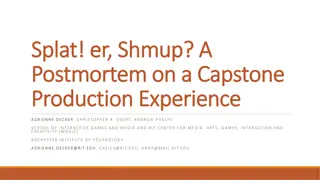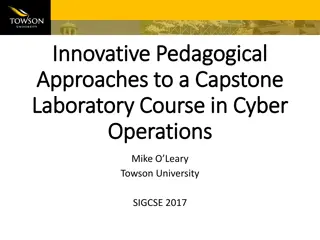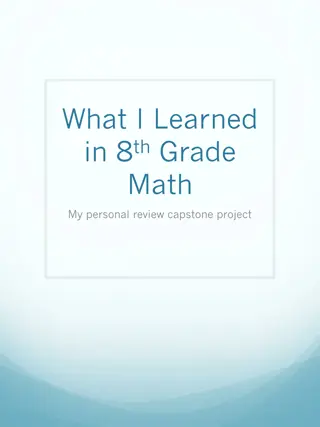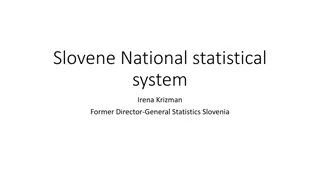Enhancing Statistical Thinking Through Capstone Projects
This Capstone Project from North Carolina State University aims to support statistical thinking by providing an in-depth understanding of why and how statistical investigations are conducted. By focusing on question posing and analysis, students can develop essential skills in statistical reasoning and application.
Download Presentation

Please find below an Image/Link to download the presentation.
The content on the website is provided AS IS for your information and personal use only. It may not be sold, licensed, or shared on other websites without obtaining consent from the author.If you encounter any issues during the download, it is possible that the publisher has removed the file from their server.
You are allowed to download the files provided on this website for personal or commercial use, subject to the condition that they are used lawfully. All files are the property of their respective owners.
The content on the website is provided AS IS for your information and personal use only. It may not be sold, licensed, or shared on other websites without obtaining consent from the author.
E N D
Presentation Transcript
Supporting Statistical Thinking Through a Capstone Project Herle McGowan (herle_mcgowan@ncsu.edu) Roger Woodard (woodard@stat.ncsu.edu) North Carolina State University
Statistical Thinking Understanding of why and how statistical investigations are conducted Question posing Data collection Choosing analyses Being able to understand and utilize the context of a problem to plan and evaluate investigations and to draw conclusions. https://app.gen.umn.edu/artist/glossary.html
GAISE Guidelines for Assessment and Instruction in Statistics Education Published, endorsed by ASA in 2005 Best-practices in statistics education Emphasize statistical literacy and develop statistical thinking Use real data Foster active learning in the classroom http://www.amstat.org/education/gaise/
GAISE: Carpentry Analogy In week 1 of the carpentry (statistics) course, we learned to use various kinds of planes (summary statistics). In week 2, we learned to use different kinds of saws (graphs). Then, we learned about using hammers (confidence intervals). Later, we learned about the characteristics of different types of wood (tests). By the end of the course, we had covered many aspects of carpentry (statistics). But I wanted to learn how to build a table (collect and analyze data to answer a question) and I never learned how to do that.
The Capstone Presents students with a real world problem involving workplace safety Using gloves to protect fingers from metal shards while sorting screws, possibly slowing workers down Has students go through full process of a statistical investigation, starting with exp. design Completed during class time at end of semester No out-of-class time required for students, instructors
Implementation 2-3 class periods Materials for experiment: Stopwatch Gardening gloves of various sizes (e.g. M/F) Container of 3 types of dry beans of various sizes 3 containers for sorting beans into Students (about 10 per group) Technology: Computer/calculator for data analysis
Step 1: Design Handout presents: The real-world problem (workplace safety) The question of interest: Does wearing the gloves make a real difference in the speed at which workers can do small manual tasks? The task: Design an experiment to answer this question A list of the available materials Reminders of the principles of good exp. design
Step 1: Design Small group (3-4 students) discussion of the design for 10-15 minutes Whole-class discussion of design for another 10-15 minutes Seek consensus on a design which can actually be carried out in a classroom setting
Step 2: Data Collection Each group (~10 students) is given a set of materials and reminded of the agreed upon experimental design Students assign roles within a group: Set-up, mix beans and get everything ready to go between runs Time keeper, to operate the stopwatch Data recorder(s), keeping accurate records about which times are with gloves and which are without Allow 40-50 mins to carry out the experiment
Step 3: Analysis Data from each group could be combined to form 1 large sample Or each group could analyze their own data Analyze data using statistical software or graphing calculator Or produce summary statistics using a spreadsheet (or graphing calculator) and then calculate test statistic and p-value by hand
Step 4: Conclusions Mean difference will be (highly) significantly different from zero Students should conclude that wearing gloves does slow down manual tasks on average
Wrapping-up the Activity We wrap-up with class-wide discussion Could have students prepare more formal reports Formal presentations likely not the best idea, since every group did the same thing
Real World Connections Motivating problem has real-world connections, but what about the conclusion? Can t recommend that workers not wear gloves Opportunity for discussion about what employers could do instead Allow workers more time to complete tasks Reduce expectations about how much workers can complete Hire more workers
Assessment How to assess statistical thinking? Mattress Castle question on Final Exam: The Mattress Castle is a store in Raleigh that sells mattresses. The store has the following statement in their advertising "Free delivery and setup of mattress and box-springs to any home in Wake County." Bob lives in Wake County) and recently purchased a mattress from the Mattress Castle. When the delivery staff arrived at Bob's home they told him it would be an extra charge ($200) to put the mattress and box-springs in Bob's bedroom. They pointed out that the advertisement had fine print that said "Extra fee for delivery to unusual bedrooms." The problem is that Bob's bedroom is on the second floor of his house and according to the delivery driver that is unusual. Bob paid the fee but is now taking the Mattress Castle to court. As part of his preparation Bob would like to use statistical evidence to support his belief that a bedroom on the second floor is not unusual. He has about 1 week to gather this evidence and prepare it for the trial. Based on what you have learned in this class what would you do to provide statistical evidence to help Bob? (Limit your answer to 2 to 5 sentences).
Notes and Tips Project elicits good discussions of: How to define/operationalize response What are sources of variation, how to deal with them Need to keep an eye on time, guide toward design that can be carried out in class Data collection can have lots of down-time Could plan alternate tasks/practice to keep other group members busy while 1 person is sorting beans If each group analyzes their own data: Ask that 1 student per group brings laptop to class for data collection day Students often need help knowing how to enter data, what to produce summary statistics for
Variation Switch back story from needing protection from metal shards (requiring thicker gloves) to limiting exposure to trace chemicals (so that thinner Latex gloves could be used) Could compare Latex gloves to no gloves Likely not significant; conclude that wearing gloves does not slow down manual tasks on average Or could compare Latex gloves to gardening gloves Practical decision about which gloves are best
Thank you! Questions? Comments?
